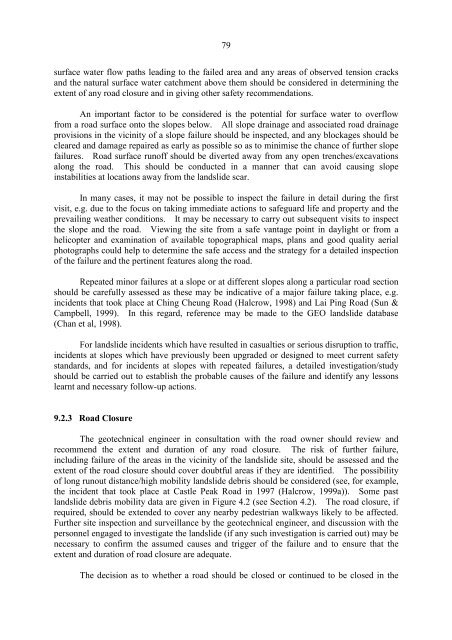Highway Slope Manual
Highway Slope Manual
Highway Slope Manual
Create successful ePaper yourself
Turn your PDF publications into a flip-book with our unique Google optimized e-Paper software.
79<br />
surface water flow paths leading to the failed area and any areas of observed tension cracks<br />
and the natural surface water catchment above them should be considered in determining the<br />
extent of any road closure and in giving other safety recommendations.<br />
An important factor to be considered is the potential for surface water to overflow<br />
from a road surface onto the slopes below. All slope drainage and associated road drainage<br />
provisions in the vicinity of a slope failure should be inspected, and any blockages should be<br />
cleared and damage repaired as early as possible so as to minimise the chance of further slope<br />
failures. Road surface runoff should be diverted away from any open trenches/excavations<br />
along the road. This should be conducted in a manner that can avoid causing slope<br />
instabilities at locations away from the landslide scar.<br />
In many cases, it may not be possible to inspect the failure in detail during the first<br />
visit, e.g. due to the focus on taking immediate actions to safeguard life and property and the<br />
prevailing weather conditions. It may be necessary to carry out subsequent visits to inspect<br />
the slope and the road. Viewing the site from a safe vantage point in daylight or from a<br />
helicopter and examination of available topographical maps, plans and good quality aerial<br />
photographs could help to determine the safe access and the strategy for a detailed inspection<br />
of the failure and the pertinent features along the road.<br />
Repeated minor failures at a slope or at different slopes along a particular road section<br />
should be carefully assessed as these may be indicative of a major failure taking place, e.g.<br />
incidents that took place at Ching Cheung Road (Halcrow, 1998) and Lai Ping Road (Sun &<br />
Campbell, 1999). In this regard, reference may be made to the GEO landslide database<br />
(Chan et al, 1998).<br />
For landslide incidents which have resulted in casualties or serious disruption to traffic,<br />
incidents at slopes which have previously been upgraded or designed to meet current safety<br />
standards, and for incidents at slopes with repeated failures, a detailed investigation/study<br />
should be carried out to establish the probable causes of the failure and identify any lessons<br />
learnt and necessary follow-up actions.<br />
9.2.3 Road Closure<br />
The geotechnical engineer in consultation with the road owner should review and<br />
recommend the extent and duration of any road closure. The risk of further failure,<br />
including failure of the areas in the vicinity of the landslide site, should be assessed and the<br />
extent of the road closure should cover doubtful areas if they are identified. The possibility<br />
of long runout distance/high mobility landslide debris should be considered (see, for example,<br />
the incident that took place at Castle Peak Road in 1997 (Halcrow, 1999a)). Some past<br />
landslide debris mobility data are given in Figure 4.2 (see Section 4.2). The road closure, if<br />
required, should be extended to cover any nearby pedestrian walkways likely to be affected.<br />
Further site inspection and surveillance by the geotechnical engineer, and discussion with the<br />
personnel engaged to investigate the landslide (if any such investigation is carried out) may be<br />
necessary to confirm the assumed causes and trigger of the failure and to ensure that the<br />
extent and duration of road closure are adequate.<br />
The decision as to whether a road should be closed or continued to be closed in the

















